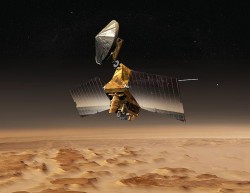NASA’s Mars Odyssey has been switched into “safe-mode” after possibly being hit by energetic particles from the Sun, or by cosmic rays. Acting as one of two relay satellites between Earth and Phoenix, this has hindered commands to be sent to the lander, thereby slowing its progress. Phoenix is just about to start scence digging operations on the surface (Martian regolith is shown in the Phoenix test-run scoop of material, pictured). It seems likely that Odyssey will remain in the protective safe-mode until the weekend whilst operators try to understand what caused the problem. For the time being, the second relay satellite NASA’s Mars Reconnaissance Orbiter (MRO) will try to take up the slack and keep the lander in contact with mission control…
This is the second communications error in the otherwise flawless Phoenix Mars mission. The first occurred two days after touch down when the MRO switched its UHF radio into standby mode. Yesterday’s (Wednesday’s) error with another Mars-orbiting satellite, Odyssey, probably won’t be repaired until Saturday. Mission engineers believe the error may have occurred when energetic space particles interrupted Odyssey’s onboard memory. As a safety precaution, the onboard hardware was switched into a low-energy state to protect it from any damage. This event doesn’t seem to be serious, but it does slow down the progress of Phoenix which is currently excavating Mars material from the surface of the red planet, trying to understand the composition of permafrost layers.
Although frustrating, this setback will not cause too many problems to Phoenix, daily commands can still be sent to the MRO and relayed to Phoenix and the first delayed science excavation run is scheduled for today. Test runs over the past few days have revealed a white substance in the fist-sized samples of regolith, so scientists are very excited to “bake” the permafrost material to see if water ice or salt deposits are present. After the preliminary tests, mission scientists believe that Phoenix’s 8-foot robotic arm is up to the task and appears to be functioning excellently.
The following steps will be carried out in the first science run scheduled to start today:
- Right of the test-dig area, scientists have identified three “science rich” zones. Phoenix will dig into areas known playfully as “Baby Bear”, “Mama Bear” and “Papa Bear”, after the “Goldilocks” fairy tale. Presumably they are looking for a dig that will be “just right”.
- The first dig will cut 3/10 of an inch into the permafrost at the location of “Baby Bear”, and scoop up the material.
- With the material safely in the scoop, Phoenix will swing its arm 90 degrees towards the onboard miniature oven. It will then wait for further commands.
- Assuming the MRO delivers the commands from mission control, Phoenix will be instructed to drop the sample into the oven so it can be baked. Instruments will be used to look deep into the vapour given off to look for signs of carbon or hydrogen-containing organic compounds. It is at this point that the lander will evaluate the samples to see whether there is in fact current water ice on the surface.
Over the next few days samples from all the Goldilocks sites will be analysed. These are exciting times, let’s hope there are no further communications problems…



such bad coincidence that a problem like this occurs just as the good stuff was about to happen : \
Does this kind of thing happen often to probes? I don’t recall hearing about this kind of thing before.
Looks like some thing does not want us to find some thing on Mars ( X-file music) 😉
But this is truly an exciting few days a head of us !
That sucks, doesn’t the satellite have EM shielding, like metal or something?
Oh well, better safe than sorry
This sort of thing happens a lot with earth-bound satellites fairly frequently. The reason you don’t hear of this happening more often with Mars satellites is because there are only 2 active man-made objects orbiting the planet, while Earth has hundreds of these objects.
Also, metal shielding is pretty much useless with regards to cosmic rays because the rays themselves are so energetic even an inch of lead can’t stop them. All metal shielding will do would be to break up the cosmic ray into hundreds of secondary radiation particles which in turn will still have a detrimental effect on electrical components in space.
The best defense we’ve got without breaking the budget is redundancy and a good back-up plan in case the on-board electronics go wonky. That’s why you hear about remote probes going into safe mode all the time. That way one can restart the probe without damaging sensitive equipment.